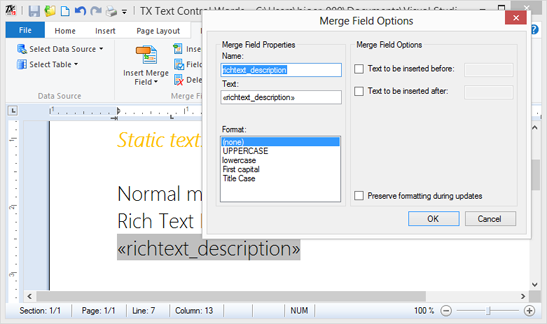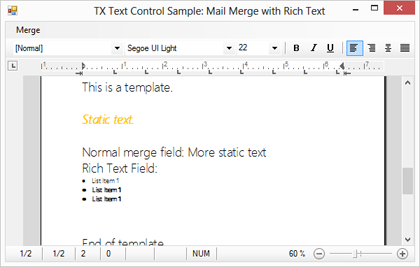Reporting: Merge Formatted Text into MergeFields Using HTML
The basic concept of Flow Type Layout Reporting is the separation of text and formatting. The template is designed in a true WYSIWYG editor and all field placehorders are formatted with the desired font and style. But sometimes, formatted text should be merged into merge fields. Consider a product description with bulleted lists, bold strings and maybe a different font family. Thanks to the powerful events provided by the DocumentServer.MailMerge class, formatted text can be injected in a…

The basic concept of Flow Type Layout Reporting is the separation of text and formatting. The template is designed in a true WYSIWYG editor and all field placehorders are formatted with the desired font and style.
But sometimes, formatted text should be merged into merge fields. Consider a product description with bulleted lists, bold strings and maybe a different font family.
Thanks to the powerful events provided by the DocumentServer.MailMerge class, formatted text can be injected in a very easy way.
All you need is a unique indicator that specifies whether the field content is formatted or not. For example: richtext_

The formatted text is simply passed as an HTML formatted string in the DataTable:
TXTextControl.LoadSettings ls = new TXTextControl.LoadSettings();
ls.ApplicationFieldFormat = TXTextControl.ApplicationFieldFormat.MSWord;
textControl1.Load("template.docx",
TXTextControl.StreamType.WordprocessingML, ls);
// create a dummy data source
DataTable dt = new DataTable();
dt.Columns.Add("normal");
dt.Columns.Add("richtext_description");
dt.Rows.Add(new object[] { "Static text",
"<span style=\'font-family: Segoe UI Light;\'>
<b>Bold Text</b> Normal <i>Italic Text</i><br />
<b>New line</b></span>" });
dt.Rows.Add(new object[] { "More static text",
"<span style=\'font-family: Segoe UI Light;\'><ul>
<li>List Item 1</li><li><b>List Item 1<b></li><li>List Item 1</li></ul>
</span>" });
// merge template
mailMerge1.Merge(dt, true);You can see that the HTML contains bold and italic text as well as a bulleted list.
The FieldMerged event occurs when a field has been merged and returns the merged field. Additionally, it is possible to change the content of the field after the merge process. The MergeField's text now contains the HTML string. In the event, a temporary ServerTextControl instance is used to load this formatted text in order to create a byte[] array that is accepted by the MergedField property of the event arguments. The event is used to convert the HTML string into formatted text which is then injected back into the document.
private void mailMerge1_FieldMerged(object sender,
TXTextControl.DocumentServer.MailMerge.FieldMergedEventArgs e)
{
if (((MergeField)e.MailMergeFieldAdapter).Name.StartsWith("richtext_")
== false)
return;
byte[] data;
using (TXTextControl.ServerTextControl tx =
new TXTextControl.ServerTextControl())
{
tx.Create();
tx.Load(((MergeField)e.MailMergeFieldAdapter).Text,
TXTextControl.StringStreamType.HTMLFormat);
tx.Save(out data, TXTextControl.BinaryStreamType.InternalUnicodeFormat);
}
e.MergedField = data;
}
You can download the sample template and Visual Studio 2012 project below:
Reporting
The Text Control Reporting Framework combines powerful reporting features with an easy-to-use, MS Word compatible word processor. Users can create documents and templates using ordinary Microsoft Word skills. The Reporting Framework is included in all .NET based TX Text Control products including ASP.NET, Windows Forms and WPF.
Related Posts
Creating Your First ASP.NET Reporting Application
This tutorial shows how to use the MailMerge component in an ASP.NET Web application to merge a template with data to create an Adobe PDF document.
New Online Sample: Build your First Report
We published a new online demo that shows how to create a report including preparing data, creating a template to merging them together.
ReportingDocumentationReportingCloud
Create your First Document with ReportingCloud
As part of our new ReportingCloud documentation, we published a guided tutorial that shows how to create a document without programming.
MailMerge: Starting Each Merge Block on a New Page
A merge block is repeated based on the number of matching data rows in the hierarchical data object. The complete merge block is cloned and inserted under the original location in the template.…
Using MailMerge with JSON Data
In the last article, we explained how to create an ASP.NET Web API to merge templates with JSON data in the payload body of an HTTP request. The focus of this article was on the Web API and…

